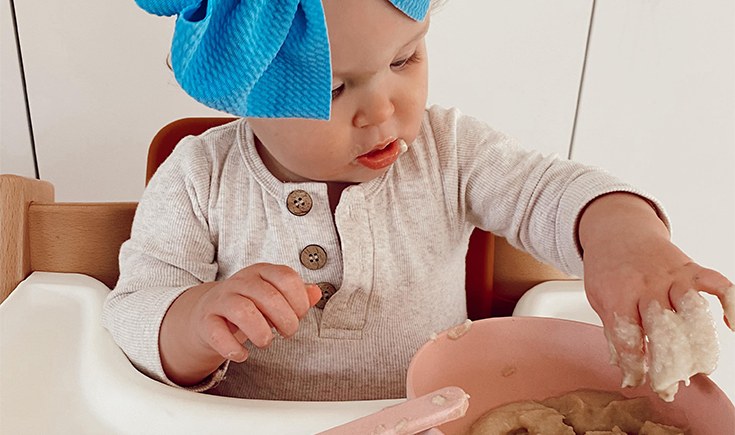

As you enter the exciting world of introducing solids to your baby, you might be wondering which approach is best—spoon-feeding purees or baby-led weaning. What’s the difference?
The traditional spoon-feeding method is when babies are offered their first tastes of pureed food via a spoon, and then the texture of the food is gradually increased as the baby is able to manage it.
The baby-led weaning method bypasses the purees and spoon feeding in favour of finger foods that a baby self-feeds.
Read the pros and cons of each feeding approach here. But, did you know that you don’t have to decide between these and only choose one approach? You can actually combine them, and instead do a mixed approach. The World Health Organisation recommends that you introduce finger foods from 6 months, so if you choose to go down the puree route, you can offer them together.
Here we’ll first show you what mixed/combination feeding looks like on a practical level with some food ideas. It might sound like double the work, but it truly isn’t any extra fuss or cooking. Then, we’ll give you some top tips for combining purees and finger foods.
It will mean that your baby is exposed to a wide variety of textures, colours, smells, and tastes, which is beneficial to their development, and helps to set them up as adventurous little eaters from the start. It’s a win for everyone!
Tips for combining purees and finger foods
Breakfast
- Offer your baby a strip of wholegrain toast with avocado, while you spoon-feed them some natural yoghurt
- Let your baby hold onto a piece of banana, while you spoon-feed them some porridge
- Give your baby a small piece of French toast, while you spoon-feed them some pureed pear, peach, and chia seeds
- Whip up a quick batch of 2 ingredient pancakes, and serve them with some plum, nectarine, and brown rice puree
Lunch/Dinner
- Pieces of soft cooked boneless fish, alongside some pureed cheesy cauliflower and broccoli
- Your baby can grab some cooked spiral pasta, while you feed them some chicken and vegetable soup
- Sweet corn fritters that fit into little hands, with spoons of pureed beef casserole
- Homemade meatballs to grasp, alongside pumpkin and green bean puree
- Boiled eggs, quartered (read more on When to introduce eggs to baby) with avocado pieces, while you offer pureed black beans and spinach
- Roast vegetable chips (sweet potato, pumpkin, parsnip, beetroot), with a bowl of mashed steamed chicken and zucchini
Tips for combining feeding methods
- It’s still beneficial for motor skill practice and exposure to different foods even if your bub only plays with and explores the finger food.
- Although you don’t have to offer foods in any particular order, you might feel more comfortable offering single ingredient purees and finger foods before gradually mixing in more ingredients.
- Ensure that the finger foods are in soft pieces that your baby can easily hold. Know the safety guidelines about how to prepare foods (you should be able ‘smoosh’ their finger foods between your thumb and forefinger).
- Educate yourself on the foods to avoid in the first year, such as honey, whole nuts, fruit juice, raw fish/meat, salt, and sugar.
- If your baby manages to gum off a piece of finger food that is too big to swallow, it will come out of their mouths again so long as they’re not sitting in a reclined position.
- Accept that it’s going to be messy, so embrace this stage. Using messy mats on the floor to collect the debris, as well as popping a feeding smock and bib on will help ease any anxiety you might have about the clean-up and extra washing.
- There’s generally no need to make extra finger foods for your baby, so cook extra at mealtimes and keep any leftover cooked veggies, meat, fish etc for a few more meals.
- When spoon-feeding, you can hold the spoon in front of your baby so that they lean forward to take a bite. This helps them to control how much they’re eating and regulate their own appetite.
- Freeze purees in ice cube trays and just heat up as you need them. It’s easy to make big batches ahead of time, and a little goes a long way, especially in the beginning when your baby might only take a teaspoon or two.
- Ensure that you’re including plenty of iron-rich foods. Here are some suggestions for both purees and finger foods.
- Get creative and relax. There are no strict rules about what to serve your baby and when. Give them roast veggies and meatballs for breakfast if you want. Babies don’t yet know about our cultural influences!
- If you want to occasionally use commercial baby food, find out if there are any good options here.
- As your baby gets the hang of spoon-feeding, they might start to push the spoon away or turn their heads. You could instead offer them a pre-loaded spoon so they have the opportunity for self-feeding. Keep a few spoons handy because they’ll inevitably end up on the floor.
- You don’t need to offer both purees and finger foods at each meal. For instance, you might like to spoon-feed them their breakfast, and then only offer finger foods for lunch (or anything that’s on your plate!). Even if you spend a few days only offering purees, and then several days with finger foods, it doesn’t matter. The great thing is how flexible it is, so do whatever is easiest for you and your baby.






















